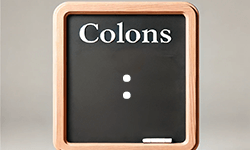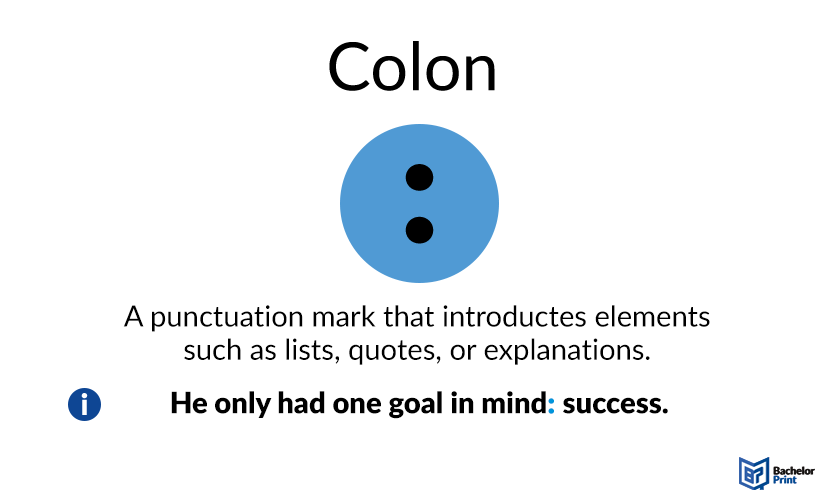
The colon is an important component of language rules, representing one of the most advanced punctuation marks in English. However, its application often poses challenges and leads to frequent misuse, leaving many students uncertain of its proper usage. This article aims to demystify the colon by providing a clear definition, addressing common queries surrounding this punctuation mark, elucidating its uses and rules, and distinguishing it from semicolons.
Definition: Colons
A colon is a punctuation mark that consists of two vertically aligned dots. It is used to create a pause that sets up expectations for the reader, indicating that what follows will provide further information related to the preceding clause or previous statement. The colon often introduces elements such as lists, quotations, or elaboration, offering clarity and emphasis within a sentence. It acts as a bridge that connects closely related ideas and enhances the coherence and readability of academic writing by clearly signaling a forthcoming elaboration.

Common uses of colons
A colon is a versatile punctuation mark that serves several important functions in writing. It is primarily used in the following contexts.
This punctuation mark can precede a list of items or a lengthy list; however, the first sentence should be able to stand on its own as a complete sentence.
This punctuation mark can introduce and connect a clause or phrase that adds further information to the preceding clause. If two independent clauses contain similar ideas that don’t directly add to or answer the information in the first part of the sentence, a semicolon would be more appropriate.
Colons are often used in prose to introduce a quotation, particularly if the introduction is an independent clause that can stand on its own. It can also be used before a quotation in running text, when the quotation is lengthy, or when it’s a formal statement. For block quotations, use a colon to end a paragraph.
In informal writing, especially in digital communication, you can form many emoticons (or smileys) with the use of a colon. It typically serves as the eyes in emoticons combined with other characters, such as dashes, numbers, hyphens, and brackets, to create facial expressions — as you can see in the third column of the table below. Before emojis and even before the rise of the Internet, emoticons were used to add a personal touch to one’s messages and help convey emotions and tone effectively in written communication.
This type of punctuation mark can separate the main title or heading from the subtitle of a book, article, or research paper.
Below is a table depicting other common uses, their functions, and examples for each.
| Uses | Functions | Examples |
| Scripts | Shows different characters. | Hanna: Are you ready? |
| Time | Separates hours and minutes. | It’s 12:30 PM. |
| Ratios | Indicates proportions. | The ratio of cats to dogs is 3:2. |
| Biblical references | Separates chapter and verse. | John 3:16 |
| Citations | Separates a volume of pages. | 2:19-31 (volume 2 from page 19 to 31) |
| Correspondence | Follows salutations in formal letters. | Dear Sir: I am writing to inform you… |
Note: British English uses a full stop instead of a colon to separate the hours from the minutes, e.g., “It’s currently 11.30.”
Capitalization with colons
In British English, the first word after a colon is not capitalized unless it is an acronym or a proper noun. When it comes to American English, things look a bit different. You should follow the specific style guide you are using (APA, MLA, Chicago, etc.).
According to the APA style and the Chicago style guides, the first word of any independent clause is suggested to be capitalized, while MLA style typically does not capitalize unless it is an acronym or a proper noun.
Colons vs. semicolons
Both grammatical colons and semicolons are used between two independent clauses or independent sentences and provide a pause in written communication. In standard English punctuation systems, a semicolon only shows that the two sentences are related without a conjunction between them; a colon shows the second sentence amplifies the first one.
Generally, the functions of the most important punctuation marks can be described as follows.
- Comma: This punctuation mark comma (,) divides sentences into more understandable sections, adds extra information, and separates items in lists. It helps to clarify meaning and ensure the reader can follow the structure of the sentence.
- Period: The punctuation mark full stop (.) ends sentences, marking a clear separation between units of meaning. It signals the completion of a thought, allowing the reader to pause before moving on to the next idea.
- Colon: This punctuation mark (:) separates a general statement from an expansion or explanation. It introduces lists, quotations, or additional information that elaborates on the preceding clause.
- Semicolon: The punctuation mark semicolon (;) indicates a break between two closely related sentences. It connects independent clauses that are closely linked in thought, offering a stronger relationship than a full stop.
- Question mark: The question mark (?) replaces a full stop at the end of a direct question. It indicates that the sentence is an enquiry, prompting the reader to consider or respond to the question posed.
- Exclamation mark: The exclamation mark (!) is used with interjections and conveys shock, surprise, anger, or emphasis. It adds emotional intensity to a sentence, signaling a strong reaction or command to the reader.
FAQs
Example
He had one goal: success.
You use a colon to introduce lists, explanations, quotations, or to separate titles and subtitles.
It introduces additional information that elaborates on the preceding clause.
Colons introduce or explain; semicolons connect closely related independent clauses.
